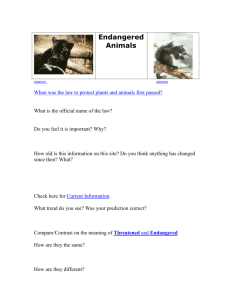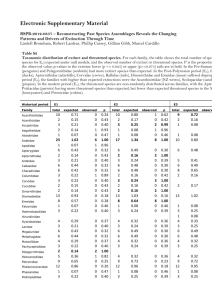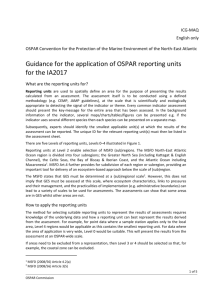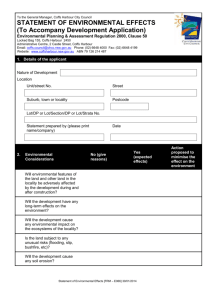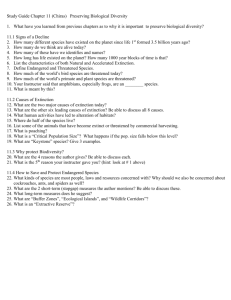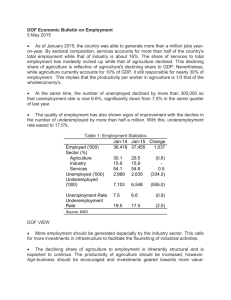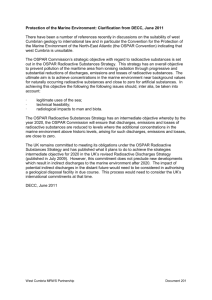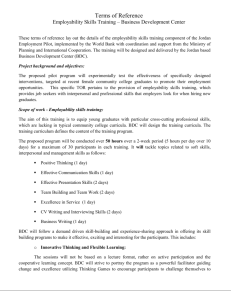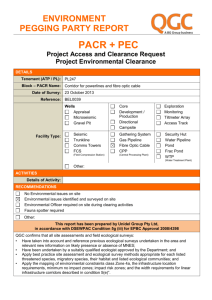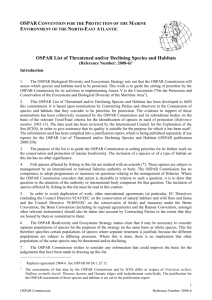Presented by WWF - CHARLIE-GIBBS MARINE PROTECTED AREA
advertisement
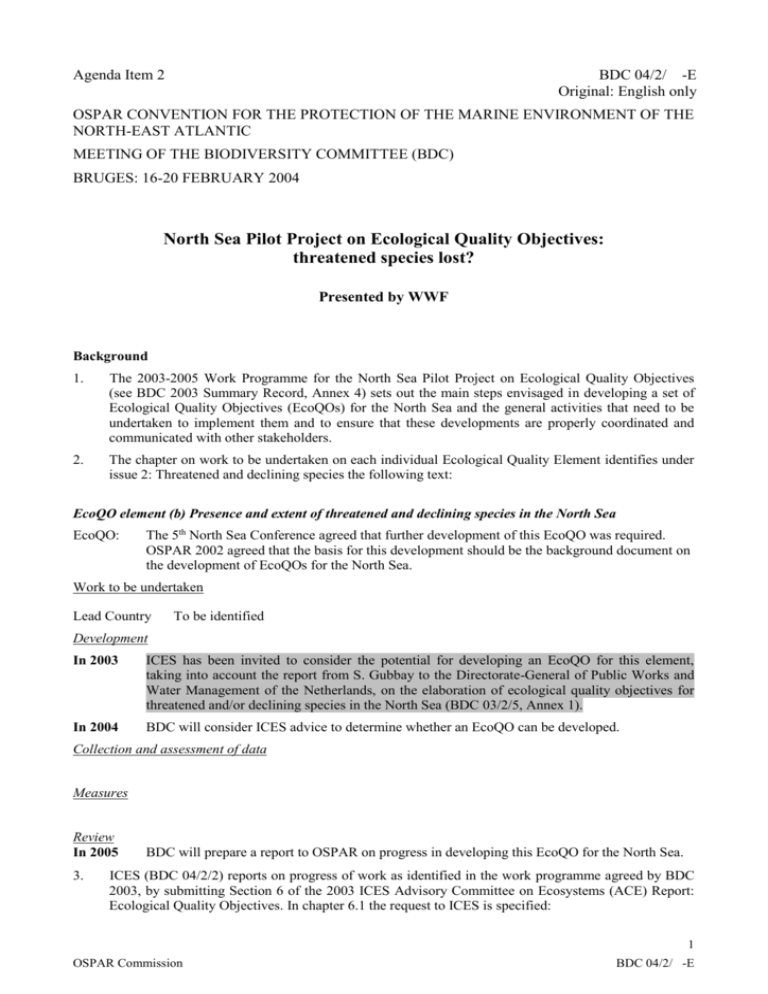
Agenda Item 2 BDC 04/2/ -E Original: English only OSPAR CONVENTION FOR THE PROTECTION OF THE MARINE ENVIRONMENT OF THE NORTH-EAST ATLANTIC MEETING OF THE BIODIVERSITY COMMITTEE (BDC) BRUGES: 16-20 FEBRUARY 2004 North Sea Pilot Project on Ecological Quality Objectives: threatened species lost? Presented by WWF Background 1. The 2003-2005 Work Programme for the North Sea Pilot Project on Ecological Quality Objectives (see BDC 2003 Summary Record, Annex 4) sets out the main steps envisaged in developing a set of Ecological Quality Objectives (EcoQOs) for the North Sea and the general activities that need to be undertaken to implement them and to ensure that these developments are properly coordinated and communicated with other stakeholders. 2. The chapter on work to be undertaken on each individual Ecological Quality Element identifies under issue 2: Threatened and declining species the following text: EcoQO element (b) Presence and extent of threatened and declining species in the North Sea EcoQO: The 5th North Sea Conference agreed that further development of this EcoQO was required. OSPAR 2002 agreed that the basis for this development should be the background document on the development of EcoQOs for the North Sea. Work to be undertaken Lead Country To be identified Development In 2003 ICES has been invited to consider the potential for developing an EcoQO for this element, taking into account the report from S. Gubbay to the Directorate-General of Public Works and Water Management of the Netherlands, on the elaboration of ecological quality objectives for threatened and/or declining species in the North Sea (BDC 03/2/5, Annex 1). In 2004 BDC will consider ICES advice to determine whether an EcoQO can be developed. Collection and assessment of data Measures Review In 2005 3. BDC will prepare a report to OSPAR on progress in developing this EcoQO for the North Sea. ICES (BDC 04/2/2) reports on progress of work as identified in the work programme agreed by BDC 2003, by submitting Section 6 of the 2003 ICES Advisory Committee on Ecosystems (ACE) Report: Ecological Quality Objectives. In chapter 6.1 the request to ICES is specified: 1 OSPAR Commission BDC 04/2/ -E 3. Further work to develop Ecological Quality Objectives 3.1. ... 3.2. Commence development, on the basis of the criteria for sound EcoQOs established by ICES in 2001, of related metrics, objectives, and reference levels for the EcoQOs relating to .... and (xiv) [(b)] presence and extent of threatened and declining species in the North Sea. c. for EcoQ element (xiv), consider the invertebrate and fish species and the habitats on the draft OSPAR list of threatened and declining species for their relevance and usefulness as a basis for EcoQOs for the North Sea; and d. where possible and appropriate for EcoQO elements .... and (xiv) , reconstruct the historic trajectory of the metrics and determine their historic performance ... 4. However, Section 6 of the 2003 ICES Advisory Committee on Ecosystems (ACE) Report on Ecological Quality Objectives does not discuss nor develop any EcoQO on (b) the presence and extent of threatened and declining species in the North Sea, at all. There is not even mention in the text that this particular part of the work programme was not yet finalized or is missing for other reasons. 5. The ICES working group on Ecosystem Effects of Fishing Activities (WG ECO under ACE) did in fact carry out the work given in the above text, as formulated in the request to ICES, which is reflected in chapter 5.4 of the working group report of April 2003 but which is not included in the 2003 ACE Report. However, their terms of reference, as quoted above, led them to only review the species and habitats listed on the Initial OSPAR list of threatened and declining species and habitats for their relevance and usefulness for EcoQOs for the North Sea. 6. WWF is deeply concerned about this procedure which was initiated in 2001 in the Background Document on the Development (within the OSPAR framework) of Ecological Quality Objectives (EcoQOs) for the North Sea, and submitted by the OSPAR secretariat to CONSSO 2002 (CONSSO Jan02/3/34), however, there it reads: 2. Threatened and declining species 2.1 Presence and extent of threatened and declining species in the North Sea ... General remarks and suggested further actions A list of 301 marine species identified as threatened and/or declining by international programmes or, for the majority of species, by North Sea States for their own national conservation programmes, has been compiled using the following sources: OSPAR (information submitted by Contracting Parties), IUCN, EC Habitats Directive, Bern Convention, Bonn Convention, Wadden Sea Red List, national endangered species lists. The list of 301 species could be reduced by about an order of magnitude by identifying the species that are particularly vulnerable to the most serious human pressures that occur in the North Sea. These vulnerable species were generally characterised by having particular life history characteristics. Examples were suggested for all those species that are large and long-lived and/or have low fecundity, and species that are or have been subject to over-exploitation (target species), indirect impacts from exploitation (non-target species), or subject to large-scale mass mortality. Example species are: Basking Shark, Common Skate, Ocean Quahog and Common Eelgrass. These species were discussed during the stakeholder workshop. It was argued that some of the EcoQOs proposed needed further development and evaluation. In the further work there should be opportunities for links to be made with the species and habitats identified as threatened and/or declining and in need of conservation measures in accordance with OSPAR Annex V. CONSSO JAN 02/ 3/24 2 OSPAR Commission BDC 04/2/ -E 7. WWF consider it highly inappropriate to develop the EcoQOs for (b) presence and extent of threatened and declining species, and (s) restore and/or maintain habitat quality (to be put on the ICES workprogramme for 2004, see BDC 2003 SR, Annex 4) by considering only the Initial OSPAR list of threatened and declining species and habitats: a) The two issues have a fundamentally different approach: The EcoQO presence and extent of threatened and declining species in the North Sea shall set measurable management targets for (desirably) reducing the number of such defined species in the North Sea. Because of the large number of species considered to be under threat and decline in the North Sea (see below) this could be achieved by using indicator species for human impacts affecting groups of species which are particularly vulnerable by use of common traits in their life history strategies (BirdLife BDC 03/2/5, Annex 1). The Initial OSPAR list of threatened and declining species and habitats on the other hand, merely represents a collection of the most threatened and declining species (and habitats) in the OSPAR area for which documentation is available. The link to the OSPAR list reduces the value of the EcoQOs for threatened and declining species to a quality objective for these particular species, rather than for a particular type of impact. Supporting the original proposal for determining EcoQOs for threatened and declining species by way of indicator species (BirdLife BDC 03/2/5, Annex 1) ICES, (BDC 04/2/2), comes to the conclusion that for monitoring the state of benthic opportunist and sensitive species (EcoQ element o and p) , the "most promising option may be to effectively monitor the abundance of a few indicator (sentinel) species, ..." b) The spatial scales for the North Sea EcoQOs and the OSPAR list are different. The Initial OSPAR list explicitly prioritizes species and habitats of regional relevance for protection, and although the draft OSPAR lists the names of some species and habitats for OSPAR Region II in particular, any list compiling species and habitats under immediate threat and rapid decline in the North Sea only will certainly be more extensive, as indicated by the 301 species compiled in the original report by S. Gubbay/BirdLife to the Directorate-General of Public Works and Water Management of the Netherlands (BDC 03/2/5, Annex 1). c) The EcoQO "Restore and/or maintain habitat quality" is a completely separate EcoQO with the following objectives (CONSSO JAN 02/ 3/24): Reverse the decline and/or remove the threat for threatened and declining habitats. Restore and/or maintain a high natural quality with a low degree of anthropogenic disturbance for a selected representative subset of the main habitats of the North Sea. It should therefore be considered in its entirety and for the same reasons as given above for the EcoQO on threatened species, it should not be mixed with the Initial OSPAR list of threatened and declining species and habitats. Also here, the ICES 2003-2005 Work Programme for the North Sea Pilot Project on Ecological Quality Objectives (see BDC 2003 Summary Record, Annex 4) deviates from the 2002 "Background Document on the Development (within the OSPAR framework) of Ecological Quality Objectives (EcoQOs) for the North Sea", (CONSSO Jan02/3/34) which is given as a reference. d) A link between the EcoQOs and the OSPAR list suggests that prior to the development of EcoQOs for threatened and declining species and the EcoQO for habitats, the OSPAR priority list will have to be finalized prior to finalizing the work on the EcoQOs. This is unacceptable. 8. In conclusion, WWF requests that Contracting Parties consider the development of EcoQOs for the North Sea Ecological Quality Elements (b) presence and extent of threatened and declining species, and (s) restore and/or maintain habitat quality independently of the Initial OSPAR list of threatened and/or declining species and habitats. Strong links should, however, be established between these two Ecological Quality Elements and those on (o) density of sensitive species, (p) density of opportunistic species in order to avoid duplication and missing elements, respectively. 9. WWF would like to re-emphasize the urgent need for increasing the speed of the process - threatened and/or declining species are only considered as such (e.g. on a red list) when sufficient data over a sufficient time period are available - which is rare for invertebrates. North Sea-wide there are more 3 OSPAR Commission BDC 04/2/ -E than 300 species filed in red data books - but 7 years of scientific and political debate have not yet produced a single North Sea-wide conservation measure! Action requested 10. BDC is requested to clarify a) why document BDC 04/2/2 (Section 6 of ICES ACE Report) does not consider the EcoQO on threatened and declining species, as agreed by BDC 2003 b) why the request to ICES did not reflect the wording and meaning of the BDC Work Programme for ICES (BDC 2003 Summary Record, Annex 4) 11. BDC is requested to consider the development of EcoQOs for the North Sea Ecological Quality Elements (b) presence and extent of threatened and declining species, and (s) restore and/or maintain habitat quality independently of the Initial OSPAR list of threatened and/or declining species and habitats. 4 OSPAR Commission BDC 04/2/ -E
